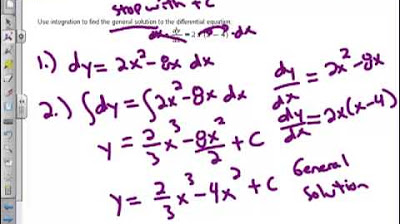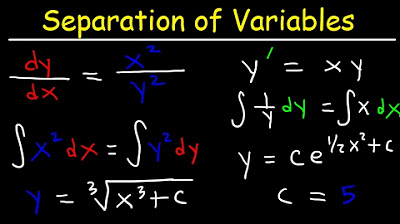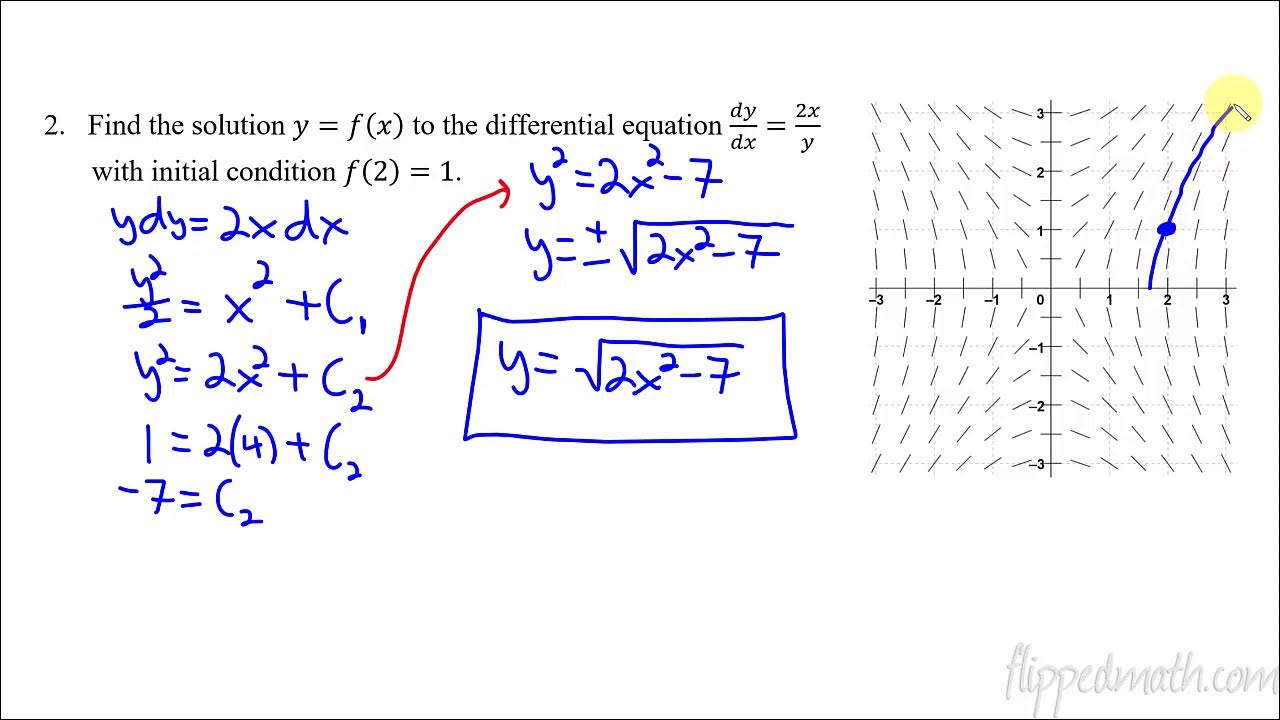Separation of Variables
TLDRIn this lesson, we explore solving differential equations using the separation of variables method. The key concept is that if two expressions are equal, their antiderivatives are also equal. We derive general solutions and particular solutions for various differential equations by separating variables and integrating both sides. We also discuss handling constants and the significance of initial conditions in determining specific solutions. Examples include solving for y in equations involving y and x, and emphasizing the importance of checking solutions through differentiation.
Takeaways
- 📚 The method of solving differential equations using separation of variables is discussed, where if two expressions are equal, their antiderivatives are also equal.
- 🔍 The general solution to a differential equation is found by considering the family of solution curves, which are separated by a constant term 'c'.
- 📉 The process of separating variables involves rearranging the equation so that all 'y' terms are on one side with their differential 'dy', and all 'x' terms on the other side with 'dx'.
- 🧩 When finding the general solution, the constant 'c' is introduced after taking antiderivatives, representing the family of solutions.
- 🔑 The specific solution is obtained by plugging in initial conditions to determine the value of the constant 'c'.
- 📝 The importance of checking antiderivatives by differentiating them to ensure they match the original differential equation is emphasized.
- 📈 The script demonstrates solving various differential equations, including those that result in exponential models, which are common in fields like biology and economics.
- 🚫 The script clarifies that not all differential equations are separable, and if an equation is not separable, it cannot be solved using the method discussed.
- ✅ The process of solving for 'y' in terms of 'x' is shown, including taking square roots and considering the plus or minus aspect based on the context of the solution curve.
- 📚 The script explains the common mistake of incorrectly taking the natural log of a term in the denominator when finding antiderivatives, and the importance of checking work.
- 🔄 The concept of odd and even roots is discussed, noting that odd roots have unique values, thus eliminating the need for a plus or minus in certain solutions.
Q & A
What is the key concept used in solving differential equations by separation of variables?
-The key concept is that if two expressions are equal, then their antiderivatives are also equal. This is based on the fact that if the derivatives of two functions are the same, then the functions themselves differ by a constant.
What is the general solution to a differential equation?
-The general solution to a differential equation is a family of solution curves that includes a constant 'c' which can vary over the real numbers, representing the different possible solutions for different initial conditions.
Why can't we solve a differential equation if it's not separable?
-If a differential equation is not separable, it means that the variables cannot be isolated on one side of the equation, making it impossible to apply the method of separation of variables to find the solution.
How do you interpret the 'plus c' in the context of differential equations?
-The 'plus c' represents the integration constant that arises when finding antiderivatives. It accounts for the family of solutions that can exist for a given differential equation, with 'c' being any real number.
What is the process of solving for a particular solution from a general solution?
-To find a particular solution, you plug in specific initial conditions, such as a given value of x and y, into the general solution to determine the value of the constant 'c', which then gives you the specific solution curve that passes through that point.
Why is it necessary to solve for y in terms of x when finding a particular solution?
-Solving for y in terms of x is necessary because a particular solution is typically expressed as y = f(x), meaning y is a function of x, and this form allows for the direct relationship between the independent and dependent variables.
What is the significance of the plus or minus in the context of square roots when solving differential equations?
-The plus or minus signifies the two possible values (positive or negative) that a square root can take. However, the choice between them depends on the specific conditions of the problem, such as the initial value of y being positive or negative.
Why is it incorrect to use the natural log of 1 over x squared as the antiderivative of 1 over x squared?
-The natural log of 1 over x squared would result in a derivative that is always positive when x is non-zero, which does not match the derivative of 1 over x squared, which is negative 2 over x. The correct antiderivative should yield the original function when differentiated.
What is the difference between an antiderivative and a derivative?
-An antiderivative is a function that, when differentiated, yields the original function. A derivative, on the other hand, is the rate of change of a function with respect to its variable. Essentially, antiderivatives 'undo' what derivatives do.
Why can't we solve a differential equation like y' = x + y using separation of variables?
-The equation y' = x + y cannot be solved using separation of variables because it does not take the form where all terms involving 'y' are on one side and all terms involving 'x' are on the other, which is a requirement for the method of separation of variables.
Outlines
📚 Introduction to Solving Differential Equations with Separation of Variables
This paragraph introduces the concept of solving differential equations using the method of separation of variables. The key idea is that if two expressions are equal, their antiderivatives will also be equal. The instructor emphasizes that the general solution to a differential equation can be found by considering the family of solution curves, each represented by 'plus c', where 'c' is a constant that varies over the real numbers. The method involves rearranging the equation to isolate variables on opposite sides and then integrating both sides to find the general solution. The paragraph also mentions that while there are other techniques for solving differential equations, separation of variables is the primary method covered in the class, and if an equation is not separable, it cannot be solved using the methods taught in the class.
🔍 Detailed Explanation of Separation of Variables and Antiderivatives
The second paragraph delves deeper into the process of separation of variables, illustrating it with an example. The instructor explains the step-by-step process of moving terms involving 'y' to one side and terms involving 'x' to the other, then integrating both sides to find antiderivatives. The example provided involves integrating 'y dy' and '−x dx', resulting in '(1/2)y^2' and '−(1/2)x^2', respectively, plus constants. The instructor clarifies the concept of 'plus c', explaining that it represents a family of solutions and that the constant 'c' can be thought of as a variable representing different solutions. The paragraph concludes with the general solution being expressed in terms of 'y' and 'x', and the importance of solving for 'y' to find a particular solution is highlighted.
📉 Applying Initial Conditions to Find Particular Solutions
This paragraph discusses the application of initial conditions to determine particular solutions from the general solution of a differential equation. The instructor provides a step-by-step guide on how to use given values of 'x' and 'y' to find the specific value of the constant 'c' in the general solution. The process involves substituting the initial conditions into the general solution and solving for 'c'. The paragraph also addresses a common question about the handling of 'plus c' during the algebraic manipulation and emphasizes the uniqueness of the third root in contrast to the square root, which may have plus or minus solutions. The importance of choosing the correct sign based on the initial condition is also highlighted.
🧩 Handling Complex Separation of Variables Scenarios
The fourth paragraph presents a more complex scenario involving the separation of variables where the differential equation includes terms that are not immediately separable. The instructor demonstrates how to rewrite the equation to facilitate separation and then integrate both sides to find the antiderivatives. The example given involves terms like '1/y dy' and '1/x^2 dx', which are rewritten as 'y^(-1) dy' and 'x^(-2) dx', respectively, and then integrated. The instructor also addresses a common mistake made when anti-differentiating '1/x^2' and clarifies why taking the natural log of '1/x^2' does not yield the correct result. The paragraph concludes with the process of solving for 'y' and finding a particular solution by plugging in given values for 'x' and 'y'.
🌐 Exploring Exponential Models and Non-Separable Equations
The final paragraph explores differential equations that are proportional to 'y', which are common in fields like biology and economics, and introduces the concept of exponential models. The instructor explains how to separate variables and integrate both sides to find the general solution, which in this case turns out to be an exponential function. The paragraph also touches on the uniqueness of solutions for odd versus even roots and the importance of initial conditions in determining the correct sign of the solution. Additionally, the instructor poses a question about a non-separable differential equation, highlighting the limitations of the separation of variables method and the need for other techniques when an equation cannot be separated.
Mindmap
Keywords
💡Differential Equations
💡Separation of Variables
💡Antiderivatives
💡General Solution
💡Particular Solution
💡Slope Fields
💡Exponential Model
💡Logarithmic Differentiation
💡Chain Rule
💡Plus C
💡Absolute Value
Highlights
Introduction to solving differential equations using separation of variables and the key concept that if two expressions are equal, their antiderivatives are also equal.
Explanation of finding the general solution to a differential equation and the role of the constant 'c' in representing a family of solution curves.
Technique of separating variables in differential equations and multiplying both sides by dy and dx to equate the expressions for anti-derivatives.
Anti-derivatives of y with respect to y and x with respect to x, leading to the general solution involving y squared and x squared.
Clarification on not adding two 'plus c's but rather considering the difference between them as a single constant.
Process of solving for y to find the general solution of a differential equation.
Discussion on the difference between general and particular solutions, with the latter requiring specific initial conditions.
Method to find a particular solution by plugging in given values for x and y to determine the constant 'c'.
Handling of differential equations with terms like the square root of x by taking anti-derivatives and simplifying.
Explanation of why the constant 'c' does not need to be distributed when taking anti-derivatives.
Approach to solving differential equations with y in the denominator by rewriting the equation and taking appropriate anti-derivatives.
Use of properties of exponents to simplify expressions involving e to the power of an expression.
Addressing common errors in anti-differentiating terms like 1/x squared and the importance of checking anti-derivatives by differentiation.
Process of finding particular solutions by using initial conditions and solving for the constant 'c'.
Discussion on the uniqueness of odd roots versus the two potential roots for even roots in solving differential equations.
Identification of when to use plus or minus in solutions based on the context and initial conditions.
Differentiation between solvable and non-solvable differential equations using separation of variables, with non-separable equations being unsolvable by this method.
Final thoughts on the importance of practice in becoming comfortable with handling constants and anti-derivatives in solving differential equations.
Transcripts
Browse More Related Video

Differential Equations BC Calculus

Separation of Variables // Differential Equations

Separable First Order Differential Equations - Basic Introduction

Separable Differential Equations (Differential Equations 12)

Calculus AB/BC – 7.7 Particular Solutions using Initial Conditions and Separation of Variables

Calculus AB Homework 7.2 Slope Fields
5.0 / 5 (0 votes)
Thanks for rating: